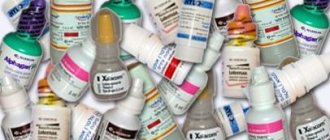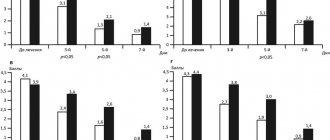Pharmacological properties of the drug Ofloxacin
Ofloxacin is an antimicrobial agent of the fluoroquinolone group. The bactericidal effect of ofloxacin, like other fluorinated quinolones, is due to its ability to block the bacterial enzyme DNA gyrase. The antibacterial spectrum of ofloxacin covers microorganisms resistant to penicillins, aminoglycosides, cephalosporins, as well as microorganisms with multiple resistance. The spectrum of action of ofloxacin includes the following types of microorganisms: Aerobic gram-negative bacteria - E. coli, Klebsiella spp., Salmonella spp., Proteus spp., Shigella spp., Yersinia spp., Enterobacter spp., Morganella morganii, Providencia spp., Vibrio spp. , Citrobacter spp., Serratia spp., Campylobacter spp., Pseudomonas aeruginosa, P. cepacia, Neisseria gonorrhoeae, N. meningitidis, Haemophilus influenzae, H. ducreyi, Acinetobacter spp., Moraxella catarrhalis, Gardnerella vaginalis, Pasteurella multocida, Helicobacter pylori. Aerobic gram-positive bacteria - staphylococci, including penicillinase-producing and methicillin-resistant strains, streptococci (especially Streptococcus pneumoniae ), Listeria monocytogenes, Corynebacterium spp. Ofloxacin is more active than ciprofloxacin against Chlamydia trachomatis . It is also active against Mycobacterium leprae and Mycobacterium tuberculosis and several other Mycobacterium . There are reports of a synergistic effect against M. leprae of ofloxacin and rifabutin. Treponema pallidum , viruses, fungi and protozoa are not susceptible to ofloxacin. Quickly and almost completely absorbed from the digestive tract. The absolute bioavailability of ofloxacin is 96% after oral administration. Plasma concentrations reach a level of 3–4 mcg/ml 1–2 hours after administration of a dose of 400 mg. Eating does not reduce the absorption of ofloxacin, but may slightly slow down the rate of absorption. The half-life is 5–8 hours. Since ofloxacin is mainly excreted by the kidneys, its pharmacokinetics changes significantly in patients with impaired renal function. Hemodialysis slightly reduces the concentration of ofloxacin in the blood serum. Ofloxacin is widely distributed in tissues and body fluids, including CSF; volume of distribution - from 1 to 2.5 l/kg. About 25% of ofloxacin is bound to plasma proteins. Ofloxacin crosses the placenta and into breast milk. Reaches high concentrations in most tissues and biological fluids of the body, including ascitic fluid, bile, saliva, bronchial secretions, gallbladder, lungs, prostate gland, bone tissue. It is mainly excreted unchanged in the urine, with 75–80% within 24–48 hours. Less than 5% of the dose is excreted in the urine as a metabolite. From 4 to 8% of the dose taken is excreted in the feces. The maximum concentration of ofloxacin in blood plasma (after intravenous administration at a dose of 200 mg for 30 minutes) is achieved almost immediately.
Side effects
Most common adverse reactions:
- nausea , loss of appetite;
- vomit;
- diarrhea , abdominal pain;
- flatulence.
Less common and very rare adverse reactions:
- transaminase activity , cholestatic jaundice ;
- hepatitis , hemorrhagic colitis , pseudomembranous colitis ;
- headache , dizziness ;
- anxiety, irritability;
- insomnia , intense dreams;
- anxiety, phobias;
- depression;
- tremor , convulsions;
- paresthesia of the limbs , peripheral neuropathy;
- conjunctivitis;
- tinnitus, hearing loss ;
- color vision disturbance, double vision;
- taste disturbances;
- tendonitis , myalgia , arthralgia , pain in the extremities;
- tendon rupture;
- palpitations, ventricular arrhythmia , hypertension ;
- dry cough , shortness of breath , bronchospasm ;
- petechiae;
- leukopenia , anemia , thrombocytopenia ;
- renal dysfunction, dysuria , urinary retention ;
- rash, itchy skin, urticaria ;
- intestinal dysbiosis.
Indications for use of the drug Ofloxacin
Infections caused by microorganisms sensitive to ofloxacin: genitourinary system - acute and chronic pyelonephritis, prostatitis, cystitis, epididymitis, surgical urinary tract infections, complicated or recurrent urinary tract infections, infections caused by Pseudomonas aeruginosa and other multidrug-resistant microorganisms, nosocominal urinary tract infections; respiratory tract infections - pneumonia, pleurisy, pleural empyema, infected bronchiectasis, chronic bronchitis in the acute phase, lung abscess, cystic fibrosis; infections of the ENT organs, including otitis media, sinusitis, tonsillitis, etc.; skin and soft tissue infections; sexually transmitted diseases - infections of the urethra, cervix, rectum, pharynx caused by penicillin-resistant gonococci, chlamydia and other microorganisms; pelvic organ infections; other infectious diseases - typhoid fever, salmonellosis, shigellosis, infections of the abdominal cavity and biliary tract; in the complex treatment of septicemia, endocarditis, osteomyelitis, mycobacterial infections, leprosy; prevention of infectious complications in patients with immunodeficiency or in patients with neutropenia; perioperative prevention or postoperative treatment of surgical infections. Eye ointment, eye/ear drops: bacterial corneal ulcers, conjunctivitis, blepharitis, stye, dacryocystitis, keratitis, chlamydial eye infections, external otitis of bacterial etiology.
Interaction
When prescribing sucralfate , antacids and drugs containing aluminum, zinc, magnesium or iron, the absorption of ofloxacin . There is an increase in the effectiveness of indirect anticoagulants when taken with this drug. Control of the coagulation system is necessary.
The risk of neurotoxic effects and convulsive activity increases with the simultaneous administration of NSAIDs, nitroimidazole and methylxanthines .
When used with Theophylline, its clearance decreases and its half-life increases.
The simultaneous use of hypoglycemic agents may lead to hypo- or hyperglycemic states.
When used with Cyclosporine, an increase in its concentration in the blood and half-life is observed.
Probenecid , Furosemide , Cimetidine and Methotrexate reduce the tubular secretion of the active substance, which leads to an increase in its concentration in the blood plasma.
A sharp decrease in blood pressure is possible when using barbiturates and antihypertensive drugs .
When used with glucocorticosteroids, there is a risk of tendon rupture.
It is possible to prolong the QT interval when using antipsychotics, antiarrhythmic drugs, tricyclic antidepressants, macrolides, imidazole derivatives, astemizole , terfenadine , ebastine .
The use of carbonic anhydrase inhibitors, sodium bicarbonate and citrates, which alkalinize the urine, increases the risk of crystalluria and nephrotoxicity.
Use of the drug Ofloxacin
The dose depends on the type of microorganism and the severity of the infection, age, body weight and kidney function of the patient. In most cases, the course of treatment is 7-10 days, treatment must be continued for another 2-3 days after the symptoms of the infection have resolved. For severe and complicated infections, therapy can be extended. The oral dose ranges from 200 mg/day to 400 mg in 2 divided doses. A dose of 400 mg can be taken at one time, preferably in the morning. A single dose of 400 mg can be recommended for acute uncomplicated gonorrhea. A dose of 400 mg is recommended by WHO for the treatment of leprosy. Depending on the severity of the infection, adults are administered IV drips from 200 to 400 mg 2 times a day. The average duration of treatment is 7–10 days. If renal function is impaired, ofloxacin is first administered at a dose of 200 mg, then - taking into account creatinine clearance (with creatinine clearance 20-50 ml/min - 100 mg every 24 hours, with creatinine clearance less than 20 ml/min - 100 mg every 48 h). Eye/ear drops: 1–2 drops of 0.3% solution into the conjunctival sac or external auditory canal every 2–4 hours for 2 days, then 4 times a day (up to 5 days). When using the drug in the form of an eye ointment, 1.5 cm strips of ointment are placed behind the lower eyelid of the affected eye 2-3 times a day; in case of chlamydial infection - 5 times a day. A combination of eye drops and ointment is possible. When using more than one drug simultaneously, the ointment should be used last.
Contraindications
- age under 18 years;
- increased sensitivity;
- pregnancy;
- breast-feeding;
- epilepsy or increased convulsive readiness after traumatic brain injury, cerebrovascular accidents and other diseases of the central nervous system;
- previously noted tendon damage after taking fluoroquinolones ;
- peripheral neuropathy;
- lactose intolerance ;
- age up to 1 year (for ointment).
It is prescribed with caution for organic diseases of the brain, myasthenia gravis , severe dysfunction of the liver and kidneys, hepatic porphyria , heart failure , diabetes mellitus , myocardial infarction , paroxysmal ventricular tachycardia , bradycardia , and in old age.
Ofloxacin analogs
Level 4 ATX code matches:
Siflox
Hyleflox
Leflobakt
Lefoccin
Gatifloxacin
Faktiv
Tigeron
Lebel
Zanotsin
Lomefloxacin
Eleflox
Lomflox
Pefloxacin
Tsiprobay
Sparflo
Tariwid
Zoflox
Abaktal
Moxifloxacin
Levofloxacin
Tablet preparations: Zanotsin , Zoflox , Ofloxin .
Solutions for infusions: Oflo , Tarivid , Ofloxabol .
An analogue of Ofloxacin, produced in the form of an eye ointment - Floxal , in the form of eye/ear drops - Dancil , Uniflox .
Ofloxacin price, where to buy
You can purchase the drug at any pharmacy. The cost depends on the manufacturer. The price of Ofloxacin in tablets of 200 mg produced in Russia (Ozon, Makiz Pharma, Sintez OJSC) ranges from 26 rubles. up to 30 rub. for 10 tablets, and the cost of tablets 400 mg No. 10 is from 53 to 59 rubles. Ofloxacin Teva, produced only in 200 mg tablets, is more expensive - 163-180 rubles. Eye ointment (Kurgan OJSC Sintez) costs from 38 to 64 rubles. in different pharmacies.
The price of Ofloxacin in Ukraine is 11-14 UAH. (tablets), 35-40 UAH. (solution for infusion).
- Online pharmacies in RussiaRussia
- Online pharmacies in UkraineUkraine
- Online pharmacies in KazakhstanKazakhstan
ZdravCity
- Ciprofloxacin tablets p.p.o.
250 mg 10 pcs. Ozon LLC 24 rub. order - Levofloxacin-Teva tablets p.p.o. 500 mg 14 pcs. Teva Pharmaceutical Enterprises Ltd.
RUR 694 order
- Levofloxacin tablets p.p.o. 500 mg 10 pcs. Ozone LLC
RUB 374 order
- Levofloxacin tablets p.p.o. 500 mg 10 pcs. Pharmstandard-Leksredstva OJSC
420 rub. order
- Ofloxacin tablets p.p.o. 200 mg 10 pcs. Ozone LLC
51 RUR order
Pharmacy Dialogue
- Ofloxacin (tablet p/o 200 mg No. 10) Teva
184 RUR order
- Ciprofloxacin (tab.p.pl/vol. 500 mg No. 10) Ozone LLC
40 rub. order
- Levofloxacin-Teva tablets 500 mg No. 7Teva Pharmaceutical
RUB 331 order
- Levofloxacin (dose solution 5 mg/ml, 100 ml bottle No. 1) Alium PFC
RUB 225 order
- Levofloxacin (tab.p.pl/vol.500mg No. 5)Vertex
RUB 317 order
show more
Pharmacy24
- Ofloxacin-Darnitsa 0.2 No. 10 tablets PrAT" Pharmaceutical company "Darnitsa", Ukraine
19 UAH. order - Ofloxacin 0.2 g No. 10 tablets AT "Lekhim-Kharkiv", Ukraine
19 UAH order
- Ofloxacin 200 mg 100 ml No. 1 solution Eurolife Healthcare Pvt. Ltd., India
45 UAH order
- Ciprofloxacin 0.2% 100 ml solution
30 UAH order
- Ciprofloxacin 0.25 No. 10 tablets PrAT "Technolog", Uman, Cherkasy region, Ukraine
15 UAH order
PaniPharmacy
- Enrofloxacin-50 100ml Ukraine, Kharkov-Product
82 UAH order
- LEVOFLOXACIN tablets Levofloxacin film-coated tablets 500 mg No. 10 Ukraine, Health LLC
145 UAH order
- Ciprofloxacin infusion Ciprofloxacin infusion solution 0.2% 100ml Ukraine, Novofarm-Biosintez LLC
18 UAH order
- Ciprofloxacin infusion Ciprofloxacin infusion solution 0.2% 100ml Ukraine, Yuria-Pharm LLC
37 UAH order
- LEVOFLOXACIN tablets Levofloxacin film-coated tablets 500 mg No. 10 Ukraine, Tekhnolog ChAO
122 UAH order
show more






